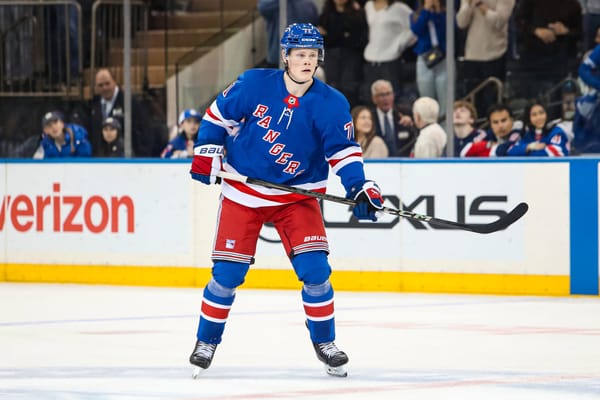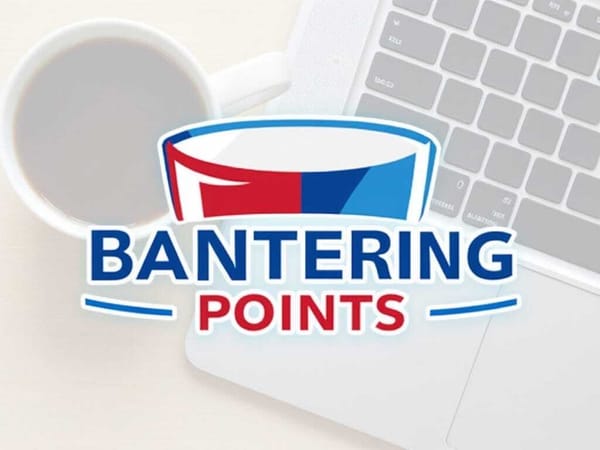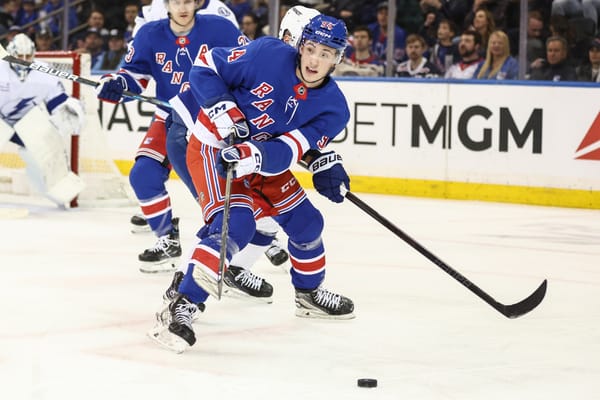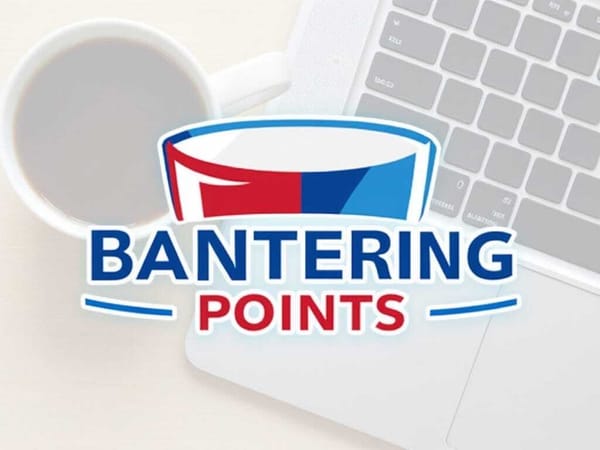Why The Rangers Shouldn’t Trade Lafreniere For Need
Trading the top pick isn’t an impossibility, but the team’s needs should have absolutely no bearing on that decision.
Rangers fans had approximately the length of a John Tortorella press conference to celebrate the team’s lottery win before being inundated with discussions of a potential trade of the first overall pick. Some of that discussion comes from people within the Rangers’ universe, so to speak. A lot more of it comes from outsiders ringing the doorbell and relentlessly trying to convince you to buy a knife set.
This is a rite of passage. Every year, no matter the team and draft outlook, a journalist will do due diligence in asking the GM if there’s any possibility of a trade, and the GM will assert due diligence in considering all possibilities. With months to kill before the draft, fans and media alike will concoct all sorts of hypotheticals.
Yet there’s a bit more seriousness to it this year. At the top of the board is the most enticing winger in years, but the team that won the pick is already well stocked at that position and has needs elsewhere.
I am not here to unequivocally shut down all discussion of a possible swap from No. 1. Assuming self-awareness and intellectual honesty, I think anything within certain moral boundaries is worth a philosophical discussion. If there’s a price for prime Wayne Gretzky, then there’s a price for anything.
Rather, my argument is that perceived team need, in itself, is not a particularly good reason to consider trading down from the top pick.
First-Overall Trades Rarely Happen
Once upon a time, those kinds of move were fairly frequent. From 1998 through 2003, the first-overall pick was traded four times in six drafts, including for a final time in 2003 when Florida sent the first pick to Pittsburgh for Marc-Andre Fleury.
In hindsight, the prices for acquiring the top pick were hilarious. In 2003, Florida — who already had a franchise goaltender in Roberto Luongo — moved the top pick and a third-round pick for the third-overall pick, Mikael Samuelsson, and pick No. 55. The price in 2002 for moving up from the second-overall pick was the right to swap first-rounders in 2003.
Suffice to say it was a completely different hockey world in the late 90s and early 00s. Scouting has dramatically improved and the salary cap has fundamentally changed the basis for building a winning hockey team, including understanding the worth of the top pick. Not for lack of tabled offers, nobody has traded down from first overall since.
NHL executives are incredibly risk-averse. The appeal of the top pick in modern hockey is tremendous. It’s a new shiny toy that gets the fans excited. Endowment effect makes people reluctant to give up what they already own, even if it’s in their own interest. And if such a trade flopped, the GM who executed it will never live it down.
The fact that such a trade rarely occurs isn’t a good argument for why it shouldn’t happen at all. But for purposes of what it would take in 2020 for the Rangers to trade the pick, there’s zero precedent. For better or worse, it’s an incredibly unlikely premise to begin with.
Would a Trade Be Worth It?
If the Buffalo Sabres called today offering Kyle Okposo for the first-overall pick, President John Davidson would laugh and hang up the phone. If they lose their minds and offer Jack Eichel, Rasmus Dahlin, and the eighth overall pick, then JD would scramble to submit signed paperwork to the NHL before someone can intervene.
Those are patronizing examples for the purpose of pointing out the obvious; whether the Rangers should trade the pick or not is contingent on what is being offered. Without direct knowledge of any potential proposals sent Davidson’s way, we can’t definitively speak to what the Rangers should or shouldn’t do.
So let’s go with the most popularly speculated trade, which would be Ottawa sending the third and fifth picks to the Rangers with the belief that center Quinton Byfield will be available for New York at No. 3. At face value it’s in the ballpark, and at minimum it would probably force Rangers management to convene for a discussion.
Let’s evaluate what such a trade would have looked like over a 15-year span of drafts.
In most cases, quality outweighs quantity. Of these 15 drafts, there are 10 in which the first-overall player is definitively worth more than the other two.
More pertinent to the discussion, though, is that in almost every year the value speaks for itself. You take Kane over Turris and Alzner because he’s provided more value than those two. You take Heiskanen and Pettersson and run in 2017 because those two together are worth dramatically more than Hischier. That would be the case for 32 different NHL teams. Only in 2011 and maybe 2009 would anyone stop to consider a particular team’s need at a given moment, and even then it’s a stretch.
Every year is different and a list like this is held hostage by the scouting prowess of teams who had those picks. Perhaps a discussion about 2008 becomes more interesting if the Thrashers had taken Pietrangelo third overall. If the 2020 draft featured Taylor Hall and Tyler Seguin as neck-and-neck for first overall, maybe the Rangers do trade down for Seguin’s center capabilities.
But the essential point here is that trading down has to be worth the value in a vacuum. In the Senators’ example, either the player drafted first overall is worth more or the players drafted third and fifth are worth more. Position has little to do with it.
Team Needs Change Quickly
Rewind to July 2017. The Rangers just completed the draft and free agency period. Now, Rangers General Manager Jeff Gorton has hired you as an outside consultant to evaluate the depth chart and submit a report highlighting the positions the Rangers look best and worst positioned for the future.
Two positions you’re probably asserting the most confidence in are center and left defense. At center, there is 25-year-old Kevin Hayes and 24-year-old Mika Zibanejad on the NHL roster while a 24-year-old JT Miller can also play the position. The team made two huge moves at the draft to reinforce the position with Lias Andersson and Filip Chytil. On left defense, Ryan McDonagh (27) is in his prime and Brady Skjei (23) had a phenomenal rookie year. Plus, Brendan Smith was retained and can always switch to his natural side.
The position you might have the least confidence in is right wing. Jesper Fast is a nice depth winger and Pavel Buchnevich had 20 points in 41 games. But Mats Zuccarello and Michael Grabner are approaching 30 and the prospect pool after Buchnevich is empty at right wing.
Right defense looks stable enough, with Kevin Shattenkirk and Brendan Smith recently signed and Neal Pionk and Tony DeAngelo added to the prospect pool.
Fast forward to March 2020. Suddenly, left defense is the team’s biggest immediate need, center is the team’s biggest long-term need, right wing is looking ridiculously strong from top-to-bottom, and while right defense has held strong as expected, it surprisingly has nothing to do with Shattenkirk, Smith, or Pionk.
Roster building is a never-ending puzzle and what the team needs right now isn’t necessarily what it will need in even the near future. Life happens. Players decline or get injured and prospects don’t work out as expected. Other prospects surprise. Unexpected trades present themselves. Free agents become available. Locker room problems or cap concerns force changes.
Other teams have found themselves in a similar situation as the Rangers do now. When Colorado was on the clock in 2013, they had centers Matt Duchene (22), Ryan O’Reilly (21), and Paul Stastny (26) on the roster. That did not deter them from keeping the pick and drafting Nate MacKinnon, a decision they hardly regret.
Time is relative. Chris Kreider and Artemi Panarin are signed to what any reasonable person would deem long-term contracts. Yet when those deals expire in six years, Alexis Lafreniere will be just 24 years old, right around the age that MacKinnon and Leon Draisaitl are right now.
There’s so much roster turnover every few years to the degree that most teams are largely unrecognizable in three-year intervals. If the Rangers get this right, the lottery win will, one way or another, provide them with a face of the franchise that serves as the one constant over 15-plus seasons of roster changes.
The biggest need the Rangers have is for elite talent; Lafreniere offers that. In an ideal world, he’d be a center, but this isn’t an ideal world. The primary motivation for a theoretical trade has to be that the Rangers would be acquiring more value than they are trading away. Position is besides the point. You use this pick to obtain the best player(s) you can and you build the roster around him. If that means taking Lafreniere then great. If it means a trade was presented that results in the Rangers moving the pick then even better.
Value itself will be what determines that. The team’s perceived need in 2020 absolutely should not dictate a decision the team makes with franchise-defining implications for potentially two decades ahead.




